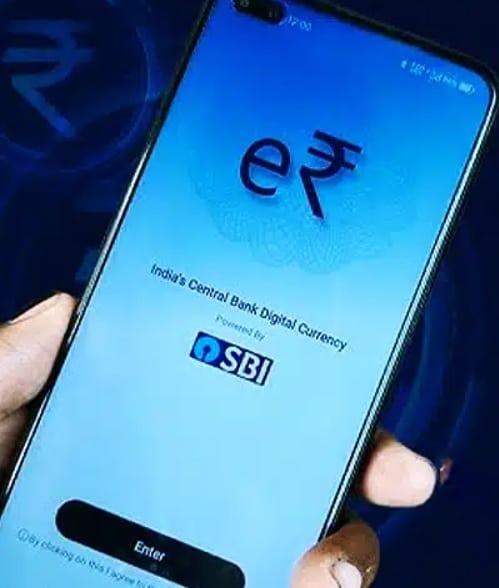What’s in today’s article?
- Why in news?
- What is Central Bank Digital Currency (CBDC)?
- News Summary: UPI QR Code-Central Bank Digital Currency interoperability
- What is UPI QR code-CBDC interoperability?
- How will it benefit customers and merchants?
- What is a QR code?
- How will interoperability help in increasing CBDC adoption?
Why in news?
- Banks are enabling the interoperability of Unified Payments Interface’s (UPI) Quick Response (QR) code with their central bank digital currency (CBDC) or e₹ application.
- Interoperability is the technical compatibility that enables a payment system to be used in conjunction with other payment systems.
- It allows system providers and participants in different systems to undertake, clear and settle payment transactions across systems without participating in multiple systems.
- With this, users of retail digital rupee will be able to make transactions by scanning any UPI QR at a merchant outlet.
- Merchants can also accept digital rupee payments through their existing UPI QR codes.
- This integration of UPI and CBDC is part of the Reserve Bank of India’s (RBI) ongoing pilot project on pushing the retail digital rupee (e₹-R).
What is Central Bank Digital Currency (CBDC)?
- About
- CBDC is the legal tender issued by a central bank in a digital form.
- The digital rupee (e-Rupee) is the digital currency launched by Reserve Bank of India.
- It is the same as a fiat currency and is exchangeable one-to-one with the fiat currency, only its form is different.
- CBDC is the legal tender issued by a central bank in a digital form.
- Launch of Digital Rupee
- RBI has demarcated the digital rupee into two broad categories: general purpose (retail) and wholesale.
- This demarcation is based on the usage and the functions performed by the digital rupee and considering the different levels of accessibility.
- From November 1, 2022, RBI launched its first pilot project to use digital rupee in the wholesale market for secondary trade in government securities (G-secs).
- Wholesale CBDC has the potential to transform the settlement systems for financial transactions undertaken by banks in the government securities (G-Sec) segment, inter-bank market and capital market more efficient and secure in terms of operational costs, use of collateral and liquidity management.
- From December 1,2022, retail digital rupee (e-R) pilot was launched.
- In effect, the retail e-rupee is an electronic version of cash, and will be primarily meant for retail transactions.
- It is available for use by all — the private sector, non-financial consumers and businesses.
- It will be distributed through intermediaries, i.e., banks.
- It will not earn any interest and can be converted to other forms of money, like deposits with banks.
- RBI has demarcated the digital rupee into two broad categories: general purpose (retail) and wholesale.
News Summary: UPI QR Code-Central Bank Digital Currency interoperability
What is UPI QR code-CBDC interoperability?
- Interoperability of UPI with the digital rupee means all UPI QR codes are compatible with CBDC apps.
- Initially, when the pilot for the retail digital rupee was launched, the e₹-R users had to scan a specific QR code to undertake transactions.
- However, with the interoperability of the two, payments can be made using a single QR code.
- The e₹ is held in a digital wallet, which is linked to a customer’s existing savings bank account.
- UPI is directly linked to a customer’s account.
How will it benefit customers and merchants?
- The interoperability of UPI and CBDC will ensure seamless transactions between a customer and merchant without having the need to switch between multiple digital platforms.
- It will allow a digital rupee user to make payments for their daily needs, such as groceries and medicines, by scanning any UPI QR codes at any merchant outlet.
- Even merchants are not required to keep a separate QR code to accept the digital rupee payments. They can accept CBDC payments on their existing QR code.
- If the merchant has a CBDC account, the payment will be settled in the CBDC wallet.
- If a merchant does not have a CBDC account, then there will be an option to make payment using UPI.
What is a QR code?
- A Quick Response (QR) code consists of black squares arranged in a square grid on a white background, which can be read by an imaging device such as a camera.
- It contains information about the item to which it is attached.
- QR code is an alternate contactless channel of payments. It allows merchants or businesses to accept payments from their customers directly into their bank accounts.
How will interoperability help in increasing CBDC adoption?
- Currently, UPI is a widely used payment method, and the interoperability between it and the CBDC will propel the adoption of the digital rupee.
- At present, more than 70 mobile apps and over 50 million merchants accept UPI payments.
- In July, RBI Deputy Governor said there were 1.3 million customers and 0.3 million merchants using the retail digital rupee.
- The daily per-day e₹-R transactions in July were around 5,000-10,000.
- The seamless integration of CBDC with UPI will enhance the acceptance and utilization of digital currencies in everyday transactions.
Q1) What are government securities?
Government securities, often referred to as government bonds or treasuries, are debt instruments issued by a government to raise funds. These securities are essentially loans that individuals, institutions, and foreign governments provide to the issuing government. In return, the government promises to pay back the principal amount (the initial investment) at a specified maturity date and usually pays periodic interest payments to the bondholders.
Q2) What is Unified Payments Interface (UPI)?
The Unified Payments Interface (UPI) is a real-time payment system and digital payments platform in India. It was developed by the National Payments Corporation of India (NPCI) to facilitate easy and instant interbank transactions and promote digital payments. UPI has become one of the most popular and widely used payment methods in India, revolutionizing the way people transfer money, make payments, and conduct financial transactions.
Last updated on June, 2025
→ UPSC Notification 2025 was released on 22nd January 2025.
→ UPSC Prelims Result 2025 is out now for the CSE held on 25 May 2025.
→ UPSC Prelims Question Paper 2025 and Unofficial Prelims Answer Key 2025 are available now.
→ UPSC Calendar 2026 is released on 15th May, 2025.
→ The UPSC Vacancy 2025 were released 1129, out of which 979 were for UPSC CSE and remaining 150 are for UPSC IFoS.
→ UPSC Mains 2025 will be conducted on 22nd August 2025.
→ UPSC Prelims 2026 will be conducted on 24th May, 2026 & UPSC Mains 2026 will be conducted on 21st August 2026.
→ The UPSC Selection Process is of 3 stages-Prelims, Mains and Interview.
→ UPSC Result 2024 is released with latest UPSC Marksheet 2024. Check Now!
→ UPSC Toppers List 2024 is released now. Shakti Dubey is UPSC AIR 1 2024 Topper.
→ Also check Best IAS Coaching in Delhi
























